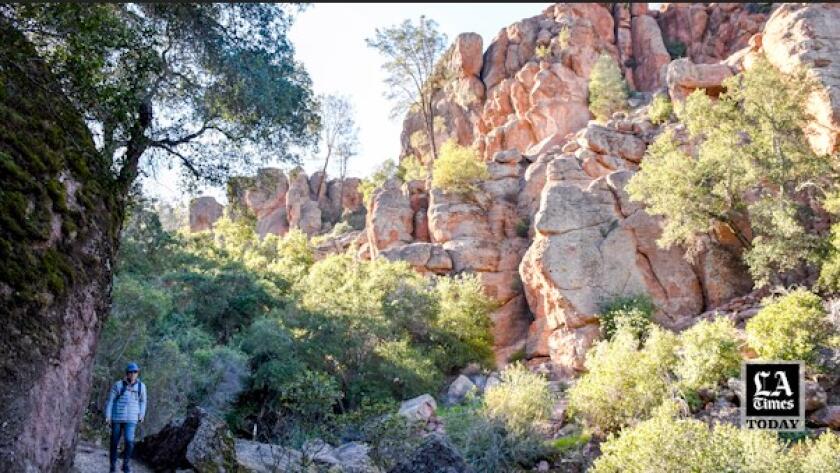Why are so many people heading to California’s newest national park?
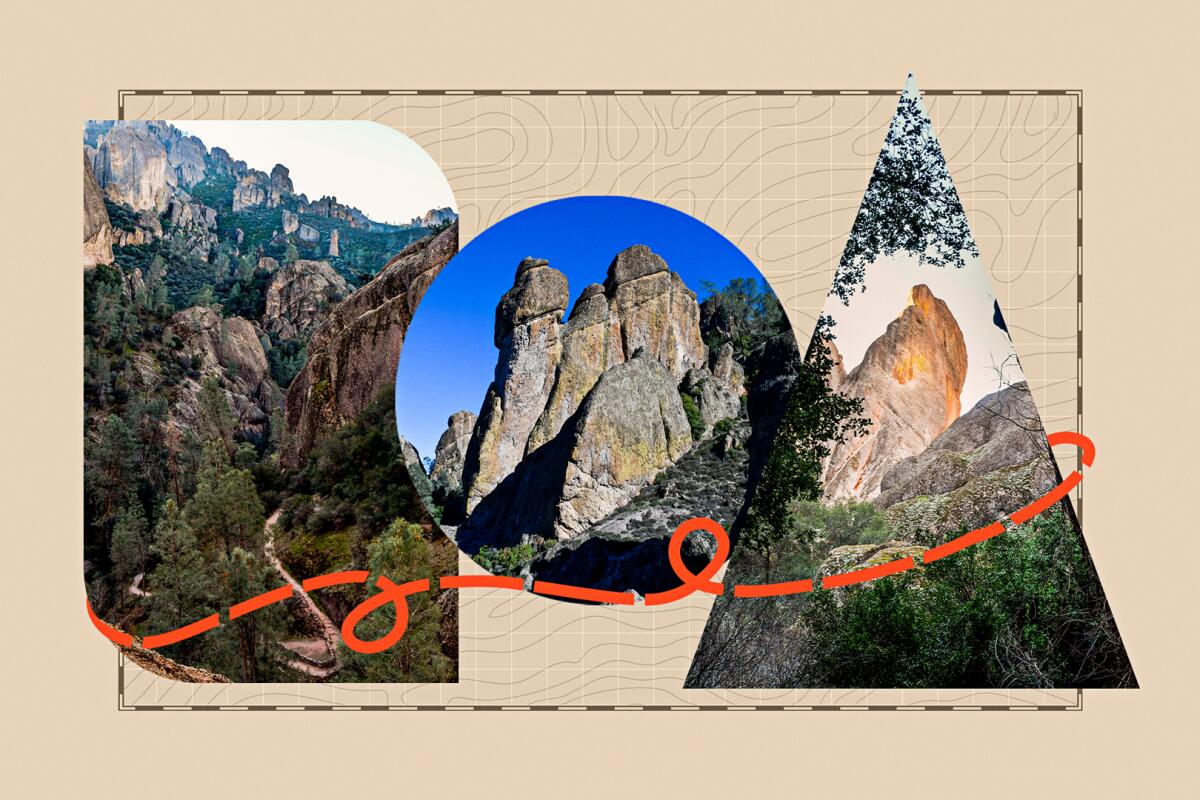
- Share via
PINNACLES NATIONAL PARK, Calif. — This strange little realm of pointy peaks, rocky caves and soaring condors is California’s youngest and smallest national park, set in a region tourists rarely see. Yet lately its visitor numbers are booming.
Is this where we should all be going?
Now that I’ve made the trip, I can tell you it’s a hoot to thread your way through its sharp, vertical rock formations while raptors glide above.
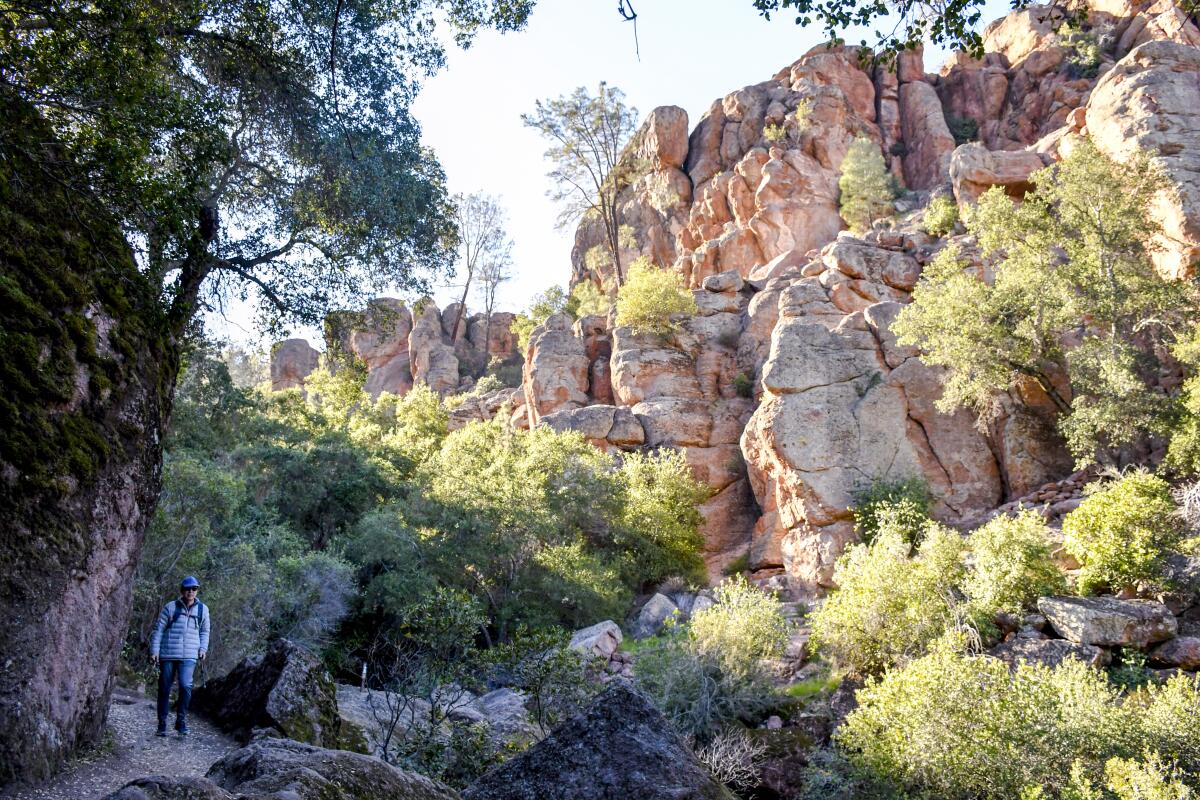
Moreover, these volcanic leftovers rise from the big, empty, underappreciated middle of California, where farms, ranches and vineyards blanket the valleys and hills, where tumbleweeds skitter and scraggly old oaks stand beside sagging barns. This makes Pinnacles National Park a literal case of needles among haystacks.
But this park is not cut out for crowds. Anyone considering a trip to this park also needs to hear some straight talk about driving, parking and sleeping.
Get The Wild newsletter.
The essential weekly guide to enjoying the outdoors in Southern California. Insider tips on the best of our beaches, trails, parks, deserts, forests and mountains.
You may occasionally receive promotional content from the Los Angeles Times.
Pinnacles sits about 280 miles up Highway 101 from Los Angeles, midway between Paso Robles and San Jose, on the eastern edge of the Salinas Valley, right behind the town of Soledad, best known for its little mission and big prison.
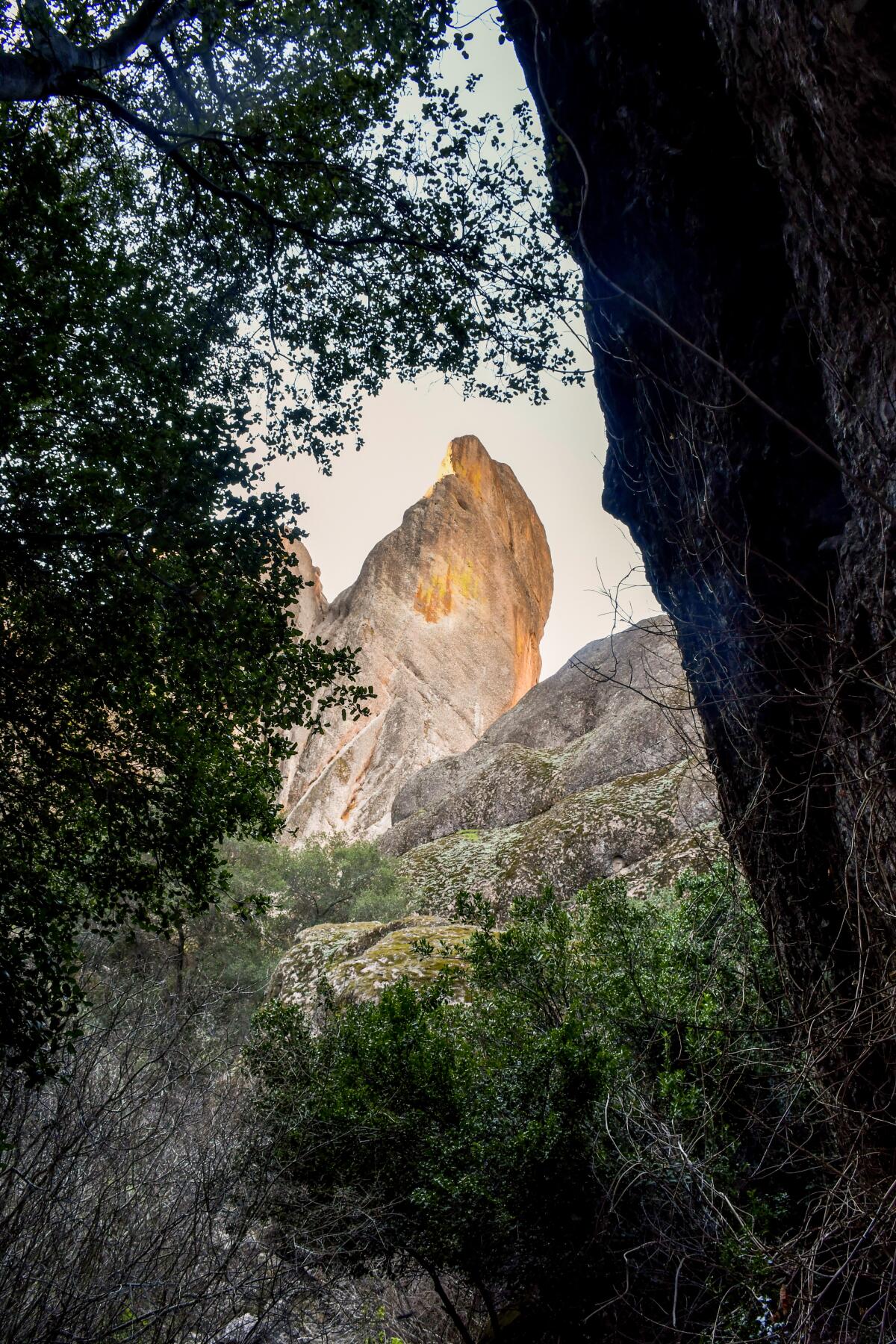
Most of the park’s visitors are from the San Francisco Bay Area. There were about 177,000 total visitors in 2019, about 348,000 in 2021, which was its busiest year in a decade.
So I drove up in early February, my first time, to see what the fuss was about. And now I’m ready for questions.
How far is this? How small?
The park, about five hours’ drive from Los Angeles, is about the size of Simi Valley: 41.5 square miles. Whether you’re headed to the east side or the west (more on that in a minute), you’ll follow a narrow, two-lane highway (in some places, one lane) through the green rolling hills and into the Gabilan mountains.

These are not especially tall mountains — no more than about 3,300 feet — but they’re steep. And their history — volcanic and seismic— has shaped them like needles, mushrooms, bowling pins and such.
Among these peaks, millennia of falling boulders have lodged in narrow canyons, creating underground spaces known as talus caves.
Can I get into these caves?
Yes, as long as you stay out of the bats’ way. Thanks to the Depression-era Civilian Conservation Corps trailblazers who crawled into these caves and started carving and stacking steps, park visitors can make their way (with flashlights) through the Balconies Cave on the west side of the park and the Bear Gulch Cave on the east side.
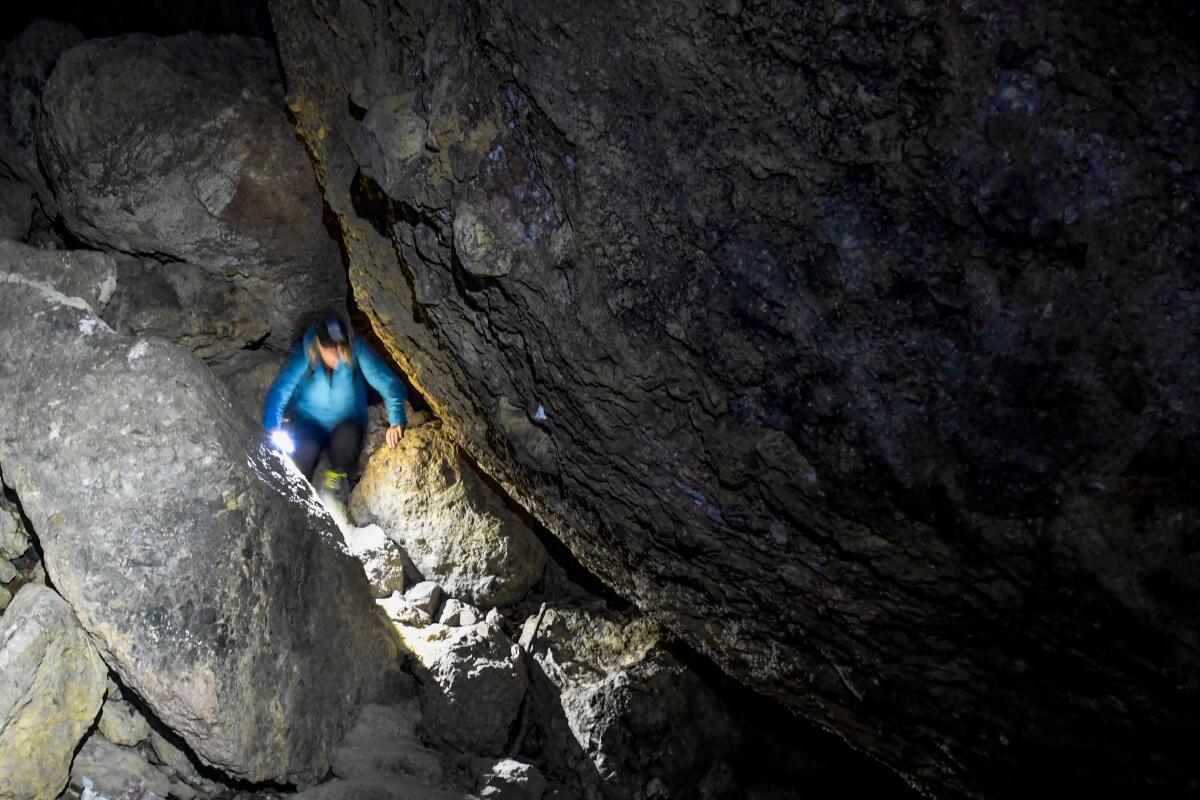
In fall, winter and spring, when the bat population is hibernating, most of the caves are usually open. Inside, you can expect to scramble over some rocks, negotiate a few tight squeezes and in Bear Gulch Cave even crawl a bit on your knees. Rangers recommend a headlamp so you can keep your hands free. Walking sticks are helpful too.
As you go, you’ll hear water trickling through and see patches of light leaking from above, a gentle reminder that huge boulders are wedged above your head. To round out the experience, I hoped for the sound of bats snoring. No luck. But also no bat smell.
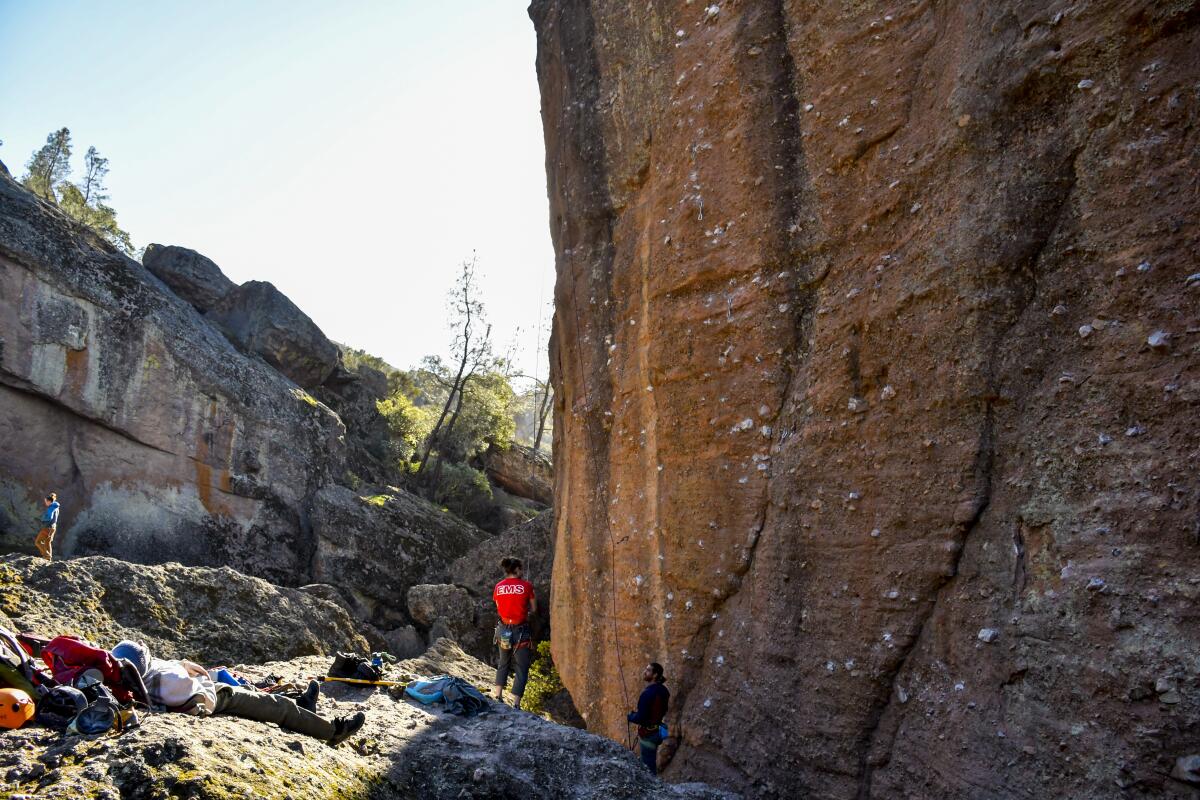
It was in Bear Gulch Cave that I met Monique Ames and her husband, Chloe Ames, with their pet bearded dragon, Copper, which was hitching a ride in Monique’s backpack. They had come from their home near Santa Cruz, Monique Ames said, after hearing of beautiful hiking trails.
She was glad to see the rumor was true. But a few minutes later, when the cave passage narrowed and the only way forward was on our knees, Chloe Ames wasn’t quite as happy.
“I had no clue it would be like this,” he said. “I’ve got a bad leg. Not going back this way.”
(It’s a loop trail, so he didn’t have to.)
So the caves are the stars?
Co-stars. After the caves, if you have the steam for a mile or two of steep hiking, you clamber up the park’s High Peaks Trail, which gets dramatically steep, narrow and, to quote the park brochure, “strenuous,” while delivering wraparound views of neighboring pinnacles and the ranches and vineyards of the Salinas Valley beyond.
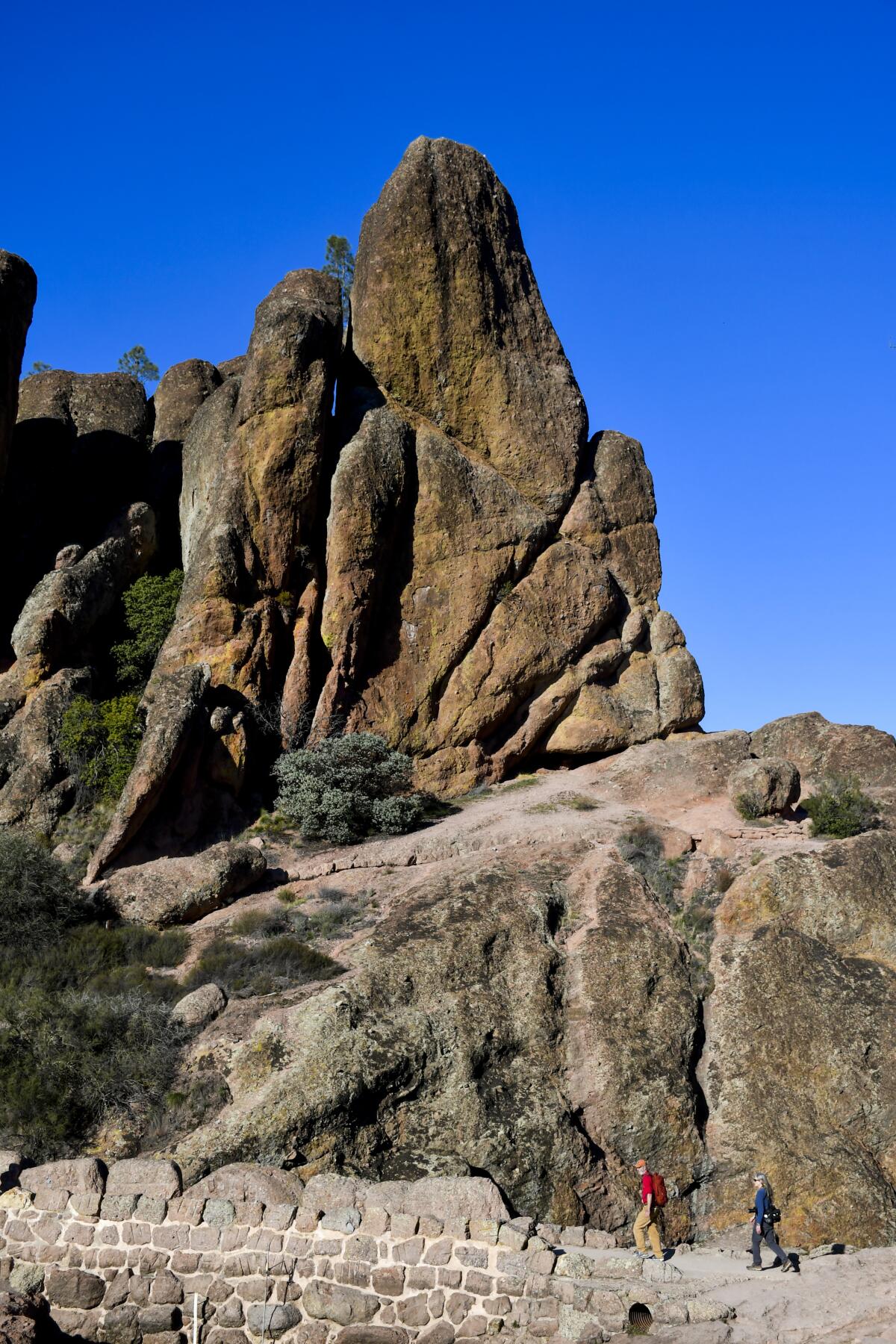
The Condor Gulch Trail has similar payoffs — spectacular views and a route that wraps around the rocks.
Rock climbers like the park too. But this is not the sturdy granite of Joshua Tree or Yosemite. The Pinnacles’ high peaks are mostly volcanic breccia, which is more vulnerable to crumbling, a different sort of challenge. Or, as the park service says, it’s “dangerous and challenging due to the inherently weak rock and poor protection.” (Also, some formations are closed annually from January through July to make room for nesting falcons and eagles.)
So, basically, for claustrophobics and acrophobics, this is hell on Earth?
Yes. And probably chiroptophobics and ornithophobics also. But for the rest of us, there are about 30 miles of trails that lead past boulder faces colored with lichen of red, orange, yellow and green. Also, the Bear Gulch Reservoir — easily reached from the east side and surrounded by boulders — is a great setting for a trailside snack.
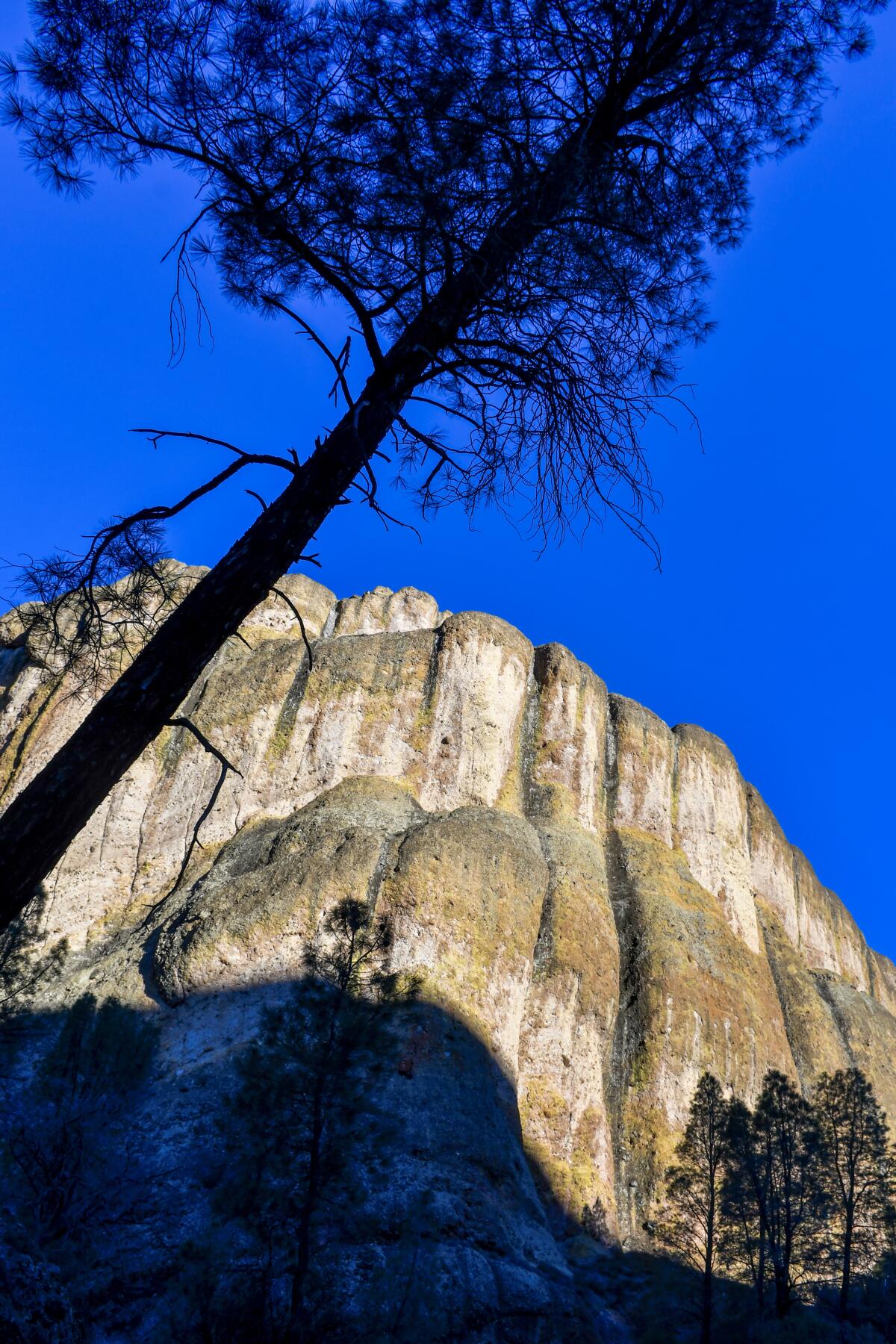
Then there are the birds. While we humans scramble around the ridges and crevices of the park, California condors, turkey vultures, eagles and assorted other raptors ride the breezes all around, some nesting among the highest minarets.
The condors, the largest wild birds in North America, are what everyone wants to see. Their wings span up to 9½ feet, and as recently as the 1980s, just 22 of them were known to exist in the world.
Now, thanks to 20 years of captive breeding and reintroduction of condors to Pinnacles and other wild places, the global population is close to 500; condorspotter.com is tracking more than 90 of the birds in Central California, and it’s common to see them in the skies above Pinnacles. My friend Carl got surprised by one on a high trail a few years ago and said it was like being buzzed by a small plane.
Did you see a condor?
Um, maybe. The challenge I found is that, with its red-orange head and a patch of white feathers under otherwise black wings, a condor at 200 feet looks a lot like a turkey vulture at 100 feet. All I can say for sure is that I saw many black birds on the lookout for dead things.
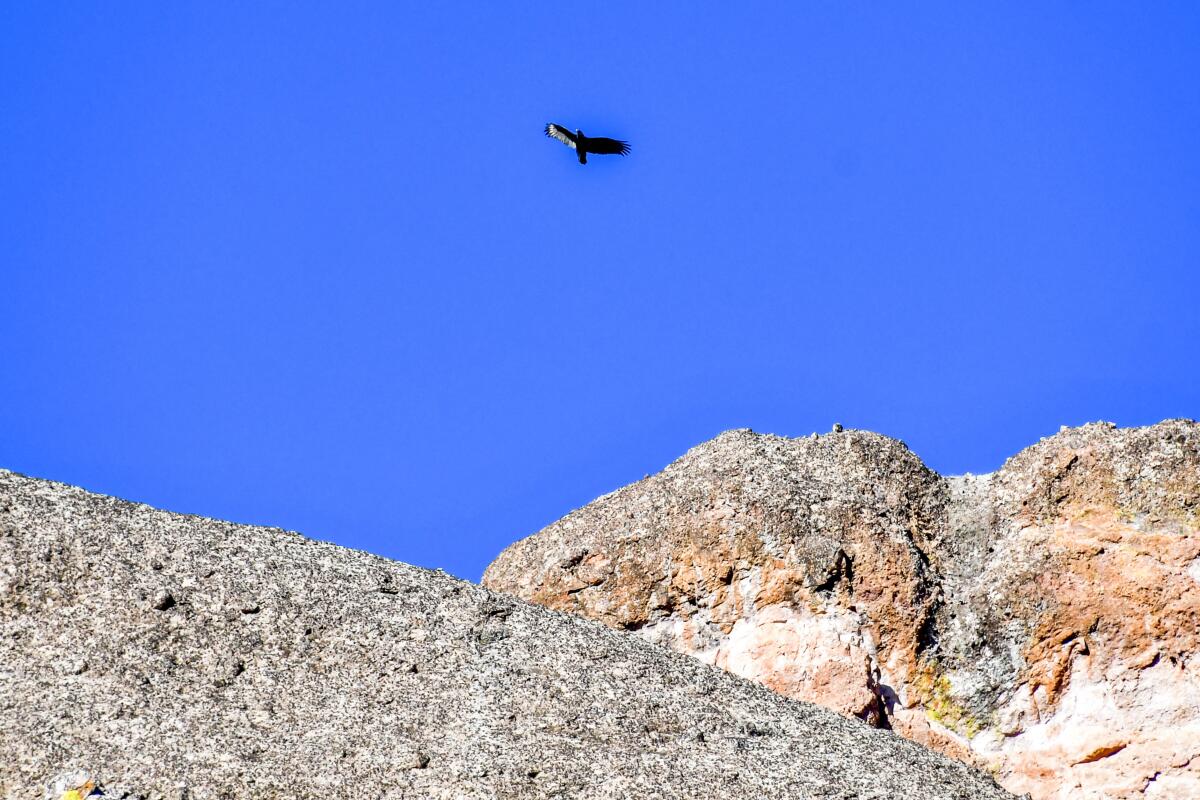
At one point, near Bear Gulch Reservoir, a couple of birders from Bend, Ore., directed my gaze to a soaring black bird straight overhead. They were sure it was a condor and they had a pair of fancy binoculars. So, you know, maybe.
“A first for me,” said the woman.
“See the white under the wings?” said the man.
Whether that was a condor or not, it was a good day, with sightings of many vultures, one eagle and a few woodpeckers. I also spied on several deer as they spied on a pair of grounded turkey vultures, which ambled along a trail with their tail feathers fanned out as if awaiting a photo shoot. I was thinking a few pilgrims in big, white hats might come around the corner next.
So why is this place only getting busy now?
Rangers say they’re not sure. But there seem to be a lot of contributing factors. Pinnacles was only promoted to national park status in 2013 (after more than a century as a national monument). And many nearby cities, including San Jose, Hollister and Paso Robles, have been gaining population. Meanwhile, the pandemic has nudged many Californians into new outdoor adventures, and Yosemite’s imposition of day-trip reservation requirements last summer prompted many travelers to seek out other parks.
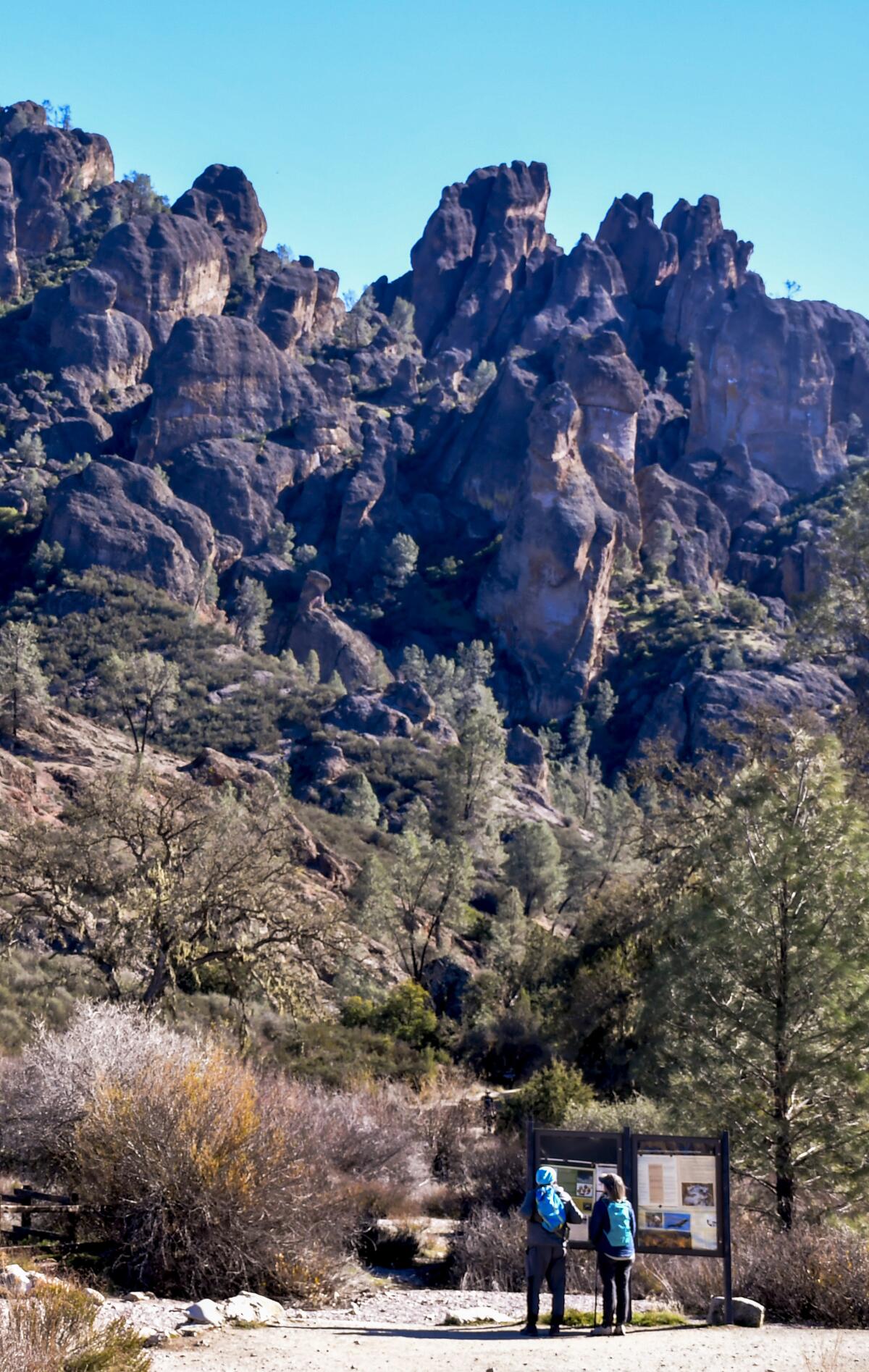
Anyway, even though the park’s features have not notably changed (except that staffing shortages have cut back some services), the upward visitor trend continues. The tentative visitor count for January 2022 — about 900 people per day — would be a pittance at larger, more navigable parks. But it was the busiest January at Pinnacles in at least 40 years.
“We feel pretty busy. For sure,” said ranger Richard Moorer.
“Word-of-mouth,” hiker Harry McKaig of Santa Cruz told me about how he ended up here. “Some friends said, ‘You’ve got to see what’s behind Soledad.’ Driving through Soledad, you wouldn’t guess there’s a park behind it.”
You said something earlier about straight talk?
Yes. Pinnacles poses at least three big logistical challenges.
The first is that there’s very little parking — just 125 spots on the west side and 300 on the east side, rangers say.
Arriving on a Tuesday afternoon and Wednesday morning, I had no problem finding spots. But on many Saturdays, Sundays and holidays — and also many weekdays in spring — Pinnacles gets “extremely high visitation,” park management warns. “Expect long lines and delays getting into the park between 9 a.m. and 3 p.m.”
Rangers can redirect people to overflow parking areas, and before the pandemic there was a shuttle bus system on the east side of the park. But the shuttle has been indefinitely shut down, and because the park’s roads are narrow and without shoulders, there’s no roadside parking.
The second challenge is that the park access is split in half. Though a few hiking trails connect the park’s eastern and western portions, there is no road between them. And it takes more than an hour to drive around the park from one entrance to the other.
As a result, most visitors choose the east side, home to a 134-site campground, a store, the main visitor center and most of the parking spaces. (For what it’s worth, the west side’s parking areas have better views of the peaks and the west entrance is more convenient to the 101. The park’s $30 vehicle entry fee is good for seven days, either or both sides.)
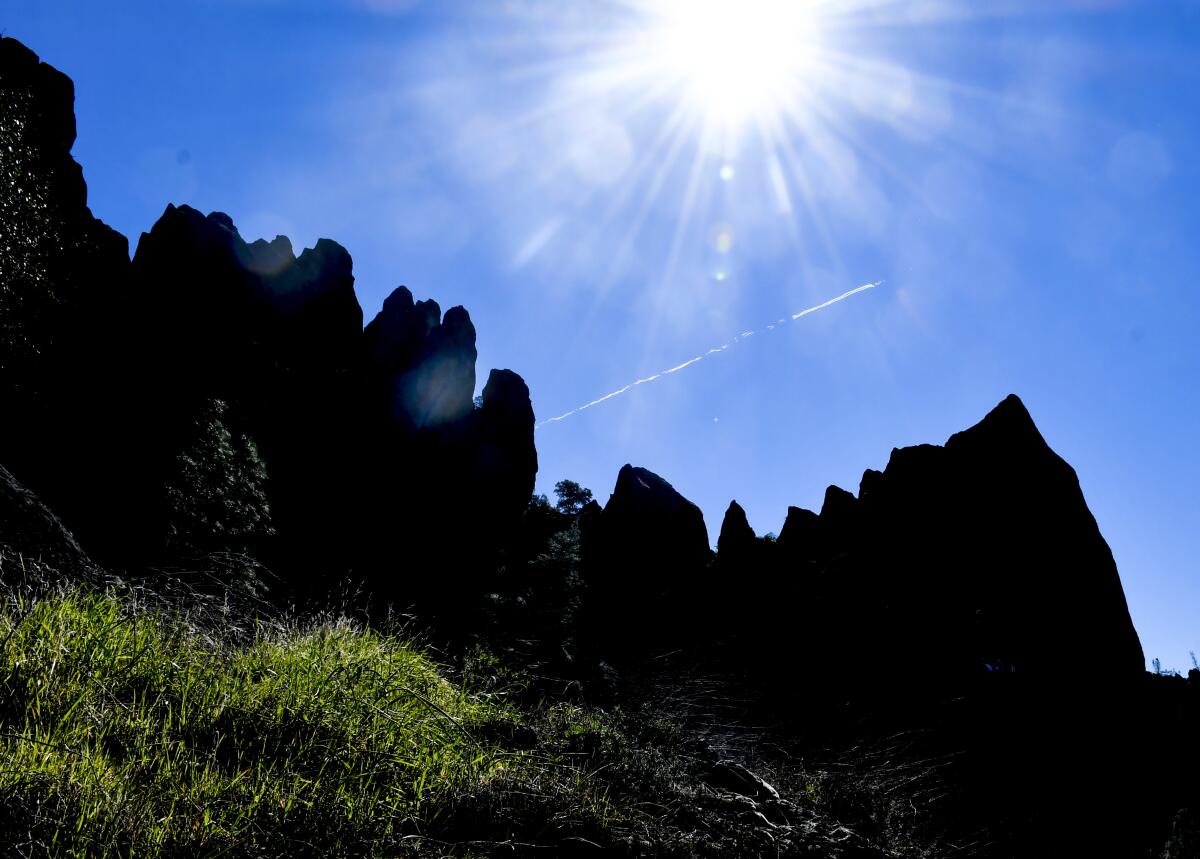
The third challenge is where to sleep if you’re not camping. It’s not an issue if you’re making a day trip from Monterey or Paso Robles. But it’s at least 25 miles to the nearest hotel on the park’s east side (outside Hollister).
On the west side, Soledad’s principal lodging options are a Motel 6 (in the process of an upgrade), a Motel 8 and the upscale Inn at the Pinnacles (six rooms starting at $260 nightly), which has a two-night minimum and doesn’t usually accept guests midweek.
The seasons are tricky too. The park gets dangerously hot in summer, often over 100 degrees, and rangers close the caves during those months, because that’s when the local bats wake from their annual hibernation.
In other words, Pinnacles is a tough nut to crack. The best strategy is probably a weekday camping trip to the east side in spring. That way, you stand a good chance of finding parking and catching the wildflower bloom, which can be impressive. (I saw only a few red ones and blue ones.) One or two nights should do it.
Get inspired to get away.
Explore California, the West and beyond with the weekly Escapes newsletter.
You may occasionally receive promotional content from the Los Angeles Times.
If you’re not camping, you’d probably want to make a Pinnacles hike part of a larger itinerary, perhaps one that includes wine tasting in Paso Robles, the aquarium in Monterey or lying low in Carmel.
Is that what you did?
No. I drove up on a Tuesday, hiked around the east side, drove an hour around the park to Soledad, dined at the Motel 6’s Windmill Restaurant (hearty, adequate) and slept at the Motel 6 ($89, adequate). The next morning, I had breakfast at Taco Bell (because the Windmill did not open at the promised time), hiked around the west side of the park, checked out the Soledad Mission and drove home Wednesday afternoon and evening, with a nap-and-coffee stop in Paso Robles.
No sane tourist would do it that way. But now I know what to do next time. And so do you.

- Share via
Watch L.A. Times Today at 7 p.m. on Spectrum News 1 on Channel 1 or live stream on the Spectrum News App. Palos Verdes Peninsula and Orange County viewers can watch on Cox Systems on channel 99.
More to Read
Sign up for The Wild
We’ll help you find the best places to hike, bike and run, as well as the perfect silent spots for meditation and yoga.
You may occasionally receive promotional content from the Los Angeles Times.
